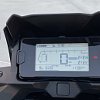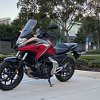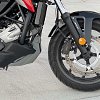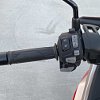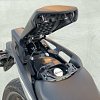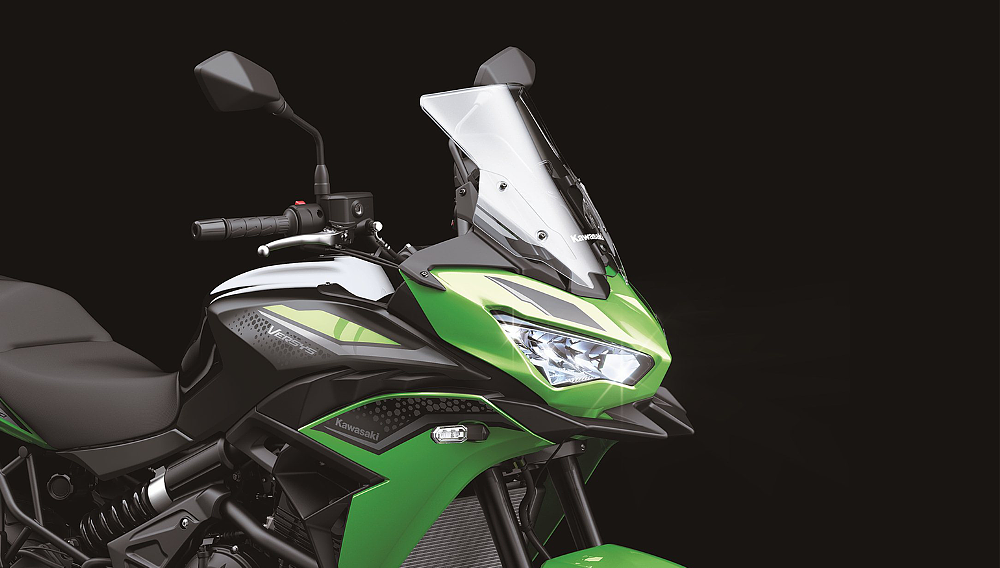In the world of motorcycles, the idea of “losing control” can take on a number of meanings. Usually it’s sliding, going too fast, sneezing, or anything else that can lead to a crash. But that’s not the kind of losing control I’m here to talk about.
This Honda NC750X DCT has, among other things, an automatic transmission. It’s a feature that seems to go a long way in building the NC’s reputation for being a motorcycle for people who don’t want to ride a motorcycle. It’s dorky. A “dad” bike. The pocket protector of motorbikes. It’s kind of heavy and fairly slow, plus it isn’t expensive or exotic, but mostly it has a system meant to take away the rider’s ability to shift when they see fit. That’s exactly the kind of control we motorcyclists love to have.

And so it represents a special, psychological loss of control for those of us who love riding. It recalled in me a memory of boarding an airplane years ago, approaching my seat and hoping desperately, as I often do, that the person sitting next to me wouldn’t be insane. Then there she was, a scrawny and well dressed young woman with an intriguing amount of facial hair and eyes flitting around like a chihuahua that just heard a door slam. “Oh boy,” I thought. “This could be a weird flight.”
The past
The NC700X first made it to U.S. shores in 2012, offering a 670 cc engine (with an 80 mm stroke and 73 mm bore) which used a slew of forward-thinking ideas cribbed from the automotive side of the company, including a car-like redline of around 6,000 rpm. There was also scooter-like storage, a fuel tank mounted under the seat, and of course the Dual Clutch Transmission (DCT) option that had debuted on the VFR1200F a couple of years prior. It was a “New Concept,” hence the NC moniker, and often returned miles-per-gallon numbers in the 60s or 70s.

The machine I tested here is similar in many ways. The parallel twin has grown to 745 cc, via four mm of bore, and Honda claims the whole unit weighs 2.6 pounds less than before. The engine still slants toward the front wheel to leave space for a storage compartment where the fuel tank normally lives on a motorcycle. The “frunk” has grown two liters over the years, for a current total of 23 liters, and still fits some helmets but not others. This NC’s engine is undersquare and focused on torque delivery, as always, but in its 750 form it has been retuned to rev just north of 7,000 rpm. Yeah, that’s right, buckle up.

More interesting are some of the nuances of the engine’s architecture. The end of the camshaft drives the water pump, one of the counterbalance shafts powers the oil pump, and the exhaust ports immediately combine to one exhaust pipe to drive heat more quickly toward the catalytic converter, thereby making the unit more efficient. Lots of neat little tricks inside, many of which aren’t noticeable while cruising down the road.
The present
Riding the NC750X and adapting to the way the bike delivers power is similar to riding a CVT-equipped scooter, opening the throttle and letting the clutch engage automatically as soon as revs rise. One quirk I noticed is that when the engine is cold the idle is set higher by the ECU — pretty standard for fuel-injected engines — and therefore the engagement of the clutch is adjusted by the bike and it doesn’t work quite as well. Similar to a manual clutch that’s cold, in some cases, and for that reason I found myself more understanding.

The other moment that the DCT struggles with is predicting when to shift at low speed, specifically when the system decides to shift down from second gear to first just as the rider picks up the throttle. This usually results in a split second of either “herky” or “jerky,” depending on your astrological sign, and then everything’s fine. It happened rarely, and frankly I found it more interesting than annoying. A computer trying to predict when you want to shift is a tricky task, and in the event that the ragged edge of the NC750’s shifting algorithm was exposed it made me realize all of the perfectly good decisions it was making the rest of the time. I also appreciate that I could use the up/down buttons on the left handlebar to suggest the bike shift while in automatic mode, or I could select manual mode and be fully in charge of when the gears would change.

As for the basic stuff, the NC is a Honda in all of the best possible ways. The seat is good, the handling is predictable, and the brakes are just powerful enough despite a soft initial bite. This motorcycle is polite and gentle to its core, the golden retriever of two-wheeled vehicles. It even loves to fetch, in so much as 23 liters of stuff in that storage area is a practical frunk-ton. I picked up a takeout order of Mexican food for four people (two bowls, two burritos, two drinks, plus guacamole and chips) and had room to spare. All of my medium-sized full-face helmets fit, some with a nudge of force to get the lid to latch, but oddly Ari’s size-small Shoei GT-Air II didn’t fit. Point being, you’ll want to try your specific helmet before you can be sure.

When it comes to those dazzling miles-per-gallon numbers, this new bike did well. The worst number I returned was 50 mpg, the best was 61. I should say that I was not particularly polite with the throttle, and it seemed like mid-60s would be easy if your riding routes contain a fair amount of 50 to 60 mph roads. Clearing 200 miles on one tank of gas should be well within reach — that’s not an impressive stat on its own, but doing it with a 3.8-gallon fuel tank isn’t something most 750 cc machines can match.
The future
Spending time in the saddle of the NC750X reminded me that if a bike is engineered well it almost doesn’t matter how strange it looks on paper or appears in person. Yamaha’s meth-smoking division came out with the three-wheeled NIKEN a few years ago and as fun as it is to make jokes it actually feels totally reasonable to ride. While it’s a psychedelic drivetrain rather than a chassis, the same goes for the automatic DCT system on this NC750. Or any other Honda, for that matter. It’s not so much “weird” as it is something other than you might have been expecting.

It’s not unlike the skinny gal in the window seat on that flight I mentioned earlier. It turned out she was a clothing model, which was a little surprising considering the facial hair, but more to the point she had interesting things to say about music, travel, and why she felt it was important to be close with her family. It was a rewarding conversation, even if I didn’t get the impression that she wanted to be friends with me any more than I did with her. If nothing else I was reminded of a good allegory for life, and motorcycles. Books, covers, you get it.

There’s no telling whether or not Honda’s New Concept is really the future of motorcycling. My impression is that it hasn’t caught on in a truly meaningful way, and maybe you see it as a baffling mutant half-scooter with no place in the world of motorbikes. I can’t say I’m about to line up to buy one, but it is a fascinating exercise in engineering. A massively complex machine packed with outside-the-box ideas, some of them subtle and others not, packaged together with the intention of providing the simplest user experience possible. If you let go of why you’re losing control and focus on how you’re losing control, it is one of the most engaging motorcycles available today.
| 2021 Honda NC750X DCT | |
|---|---|
| Price (MSRP) | $9,299 |
| Engine | 745 cc, liquid-cooled, eight-valve, parallel twin |
|
Transmission, final drive |
Six-speed, chain |
| Claimed horsepower | na |
| Claimed torque | na |
| Frame | Steel-tube trellis |
| Front suspension | Showa 41 mm fork; 4.7 inches of travel |
| Rear suspension | Showa shock, adjustable for spring preload; 4.7 inches of travel |
| Front brake | Nissin two-piston caliper, 320 mm disc with ABS |
| Rear brake | Nissin single-piston caliper, 240 mm disc with ABS |
| Rake, trail | 27.0 degrees, 4.3 inches |
| Wheelbase | 60.1 inches |
| Seat height | 31.6 inches |
| Fuel capacity | 3.8 gallons |
| Tires | Metzeler Tourance Next, 120/70ZR17 front, 160/60ZR17 rear |
| Measured weight | 493 pounds |
| Available | Now |
| Warranty | 12 months |
| More info | powersports.honda.com |





